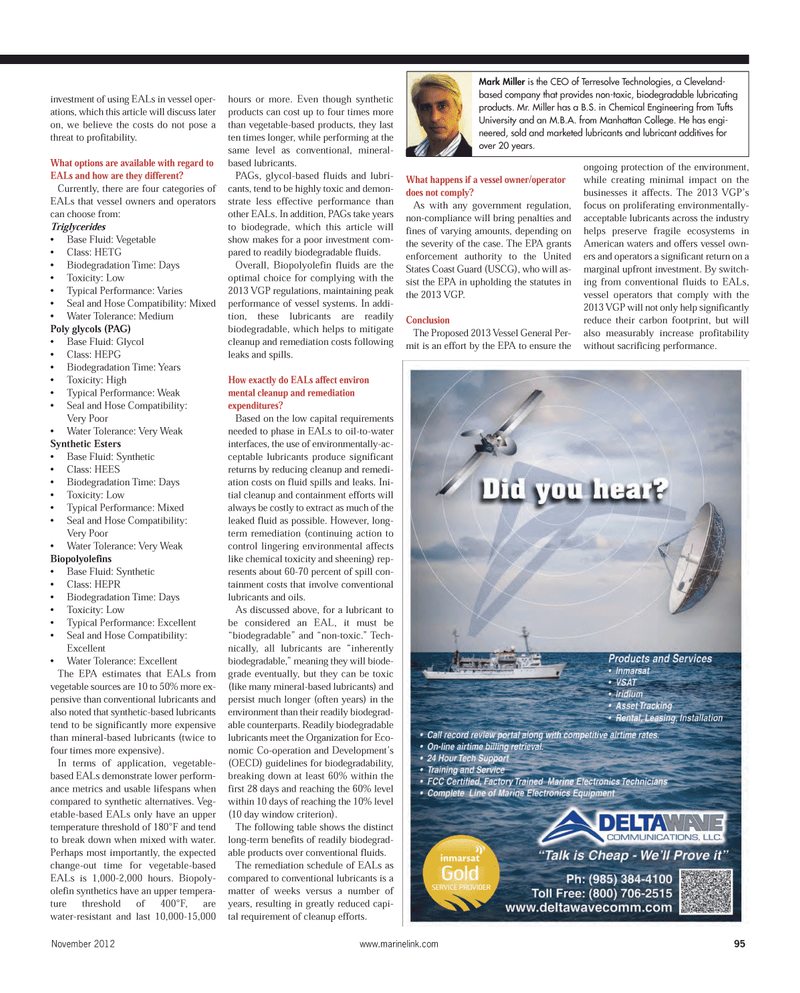
Page 95: of Maritime Reporter Magazine (November 2012)
Workboat Annual
Read this page in Pdf, Flash or Html5 edition of November 2012 Maritime Reporter Magazine
November 2012www.marinelink.com 95investment of using EALs in vessel oper- ations, which this article will discuss lateron, we believe the costs do not pose a threat to profitability. What options are available with regard to EALs and how are they different? Currently, there are four categories of EALs that vessel owners and operators can choose from: Triglycerides Base Fluid: Vegetable Class: HETG Biodegradation Time: Days Toxicity: Low Typical Performance: Varies Seal and Hose Compatibility: Mixed Water Tolerance: Medium Poly glycols (PAG) Base Fluid: Glycol Class: HEPG Biodegradation Time: Years Toxicity: High Typical Performance: Weak Seal and Hose Compatibility: Very Poor Water Tolerance: Very Weak Synthetic Esters Base Fluid: Synthetic Class: HEES Biodegradation Time: Days Toxicity: Low Typical Performance: Mixed Seal and Hose Compatibility: Very Poor Water Tolerance: Very Weak Biopolyolefins Base Fluid: Synthetic Class: HEPR Biodegradation Time: Days Toxicity: Low Typical Performance: Excellent Seal and Hose Compatibility: ExcellentWater Tolerance: Excellent The EPA estimates that EALs from vegetable sources are 10 to 50% more ex- pensive than conventional lubricants and also noted that synthetic-based lubricantstend to be significantly more expensive than mineral-based lubricants (twice tofour times more expensive). In terms of application, vegetable- based EALs demonstrate lower perform- ance metrics and usable lifespans whencompared to synthetic alternatives. Veg- etable-based EALs only have an upper temperature threshold of 180°F and tendto break down when mixed with water. Perhaps most importantly, the expected change-out time for vegetable-based EALs is 1,000-2,000 hours. Biopoly-olefin synthetics have an upper tempera- ture threshold of 400°F, are water-resistant and last 10,000-15,000 hours or more. Even though synthetic products can cost up to four times morethan vegetable-based products, they last ten times longer, while performing at the same level as conventional, mineral- based lubricants.PAGs, glycol-based fluids and lubri- cants, tend to be highly toxic and demon-strate less effective performance than other EALs. In addition, PAGs take years to biodegrade, which this article will show makes for a poor investment com- pared to readily biodegradable fluids. Overall, Biopolyolefin fluids are the optimal choice for complying with the2013 VGP regulations, maintaining peak performance of vessel systems. In addi- tion, these lubricants are readilybiodegradable, which helps to mitigate cleanup and remediation costs following leaks and spills. How exactly do EALs affect environ mental cleanup and remediation expenditures? Based on the low capital requirements needed to phase in EALs to oil-to-water interfaces, the use of environmentally-ac- ceptable lubricants produce significant returns by reducing cleanup and remedi-ation costs on fluid spills and leaks. Ini-tial cleanup and containment efforts will always be costly to extract as much of the leaked fluid as possible. However, long- term remediation (continuing action tocontrol lingering environmental affects like chemical toxicity and sheening) rep- resents about 60-70 percent of spill con-tainment costs that involve conventional lubricants and oils. As discussed above, for a lubricant to be considered an EAL, it must be?biodegradable? and ?non-toxic.? Tech- nically, all lubricants are ?inherently biodegradable,? meaning they will biode- grade eventually, but they can be toxic (like many mineral-based lubricants) and persist much longer (often years) in theenvironment than their readily biodegrad- able counterparts. Readily biodegradable lubricants meet the Organization for Eco- nomic Co-operation and Development?s (OECD) guidelines for biodegradability, breaking down at least 60% within the first 28 days and reaching the 60% level within 10 days of reaching the 10% level (10 day window criterion). The following table shows the distinct long-term benefits of readily biodegrad- able products over conventional fluids. The remediation schedule of EALs ascompared to conventional lubricants is a matter of weeks versus a number of years, resulting in greatly reduced capi-tal requirement of cleanup efforts. What happens if a vessel owner/operator does not comply?As with any government regulation, non-compliance will bring penalties andfines of varying amounts, depending on the severity of the case. The EPA grants enforcement authority to the UnitedStates Coast Guard (USCG), who will as-sist the EPA in upholding the statutes in the 2013 VGP. ConclusionThe Proposed 2013 Vessel General Per- mit is an effort by the EPA to ensure the ongoing protection of the environment, while creating minimal impact on thebusinesses it affects. The 2013 VGP?s focus on proliferating environmentally- acceptable lubricants across the industryhelps preserve fragile ecosystems in American waters and offers vessel own- ers and operators a significant return on a marginal upfront investment. By switch- ing from conventional fluids to EALs, vessel operators that comply with the 2013 VGP will not only help significantly reduce their carbon footprint, but will also measurably increase profitability without sacrificing performance. Mark Miller is the CEO of Terresolve Technologies, a Cleveland- based company that provides non-toxic, biodegradable lubricatingproducts. Mr. Miller has a B.S. in Chemical Engineering from Tufts University and an M.B.A. from Manhattan College. He has engi-neered, sold and marketed lubricants and lubricant additives forover 20 years.MR#11 (90-97) R:MR Template 11/5/2012 10:10 AM Page 95

 94
94

 96
96
